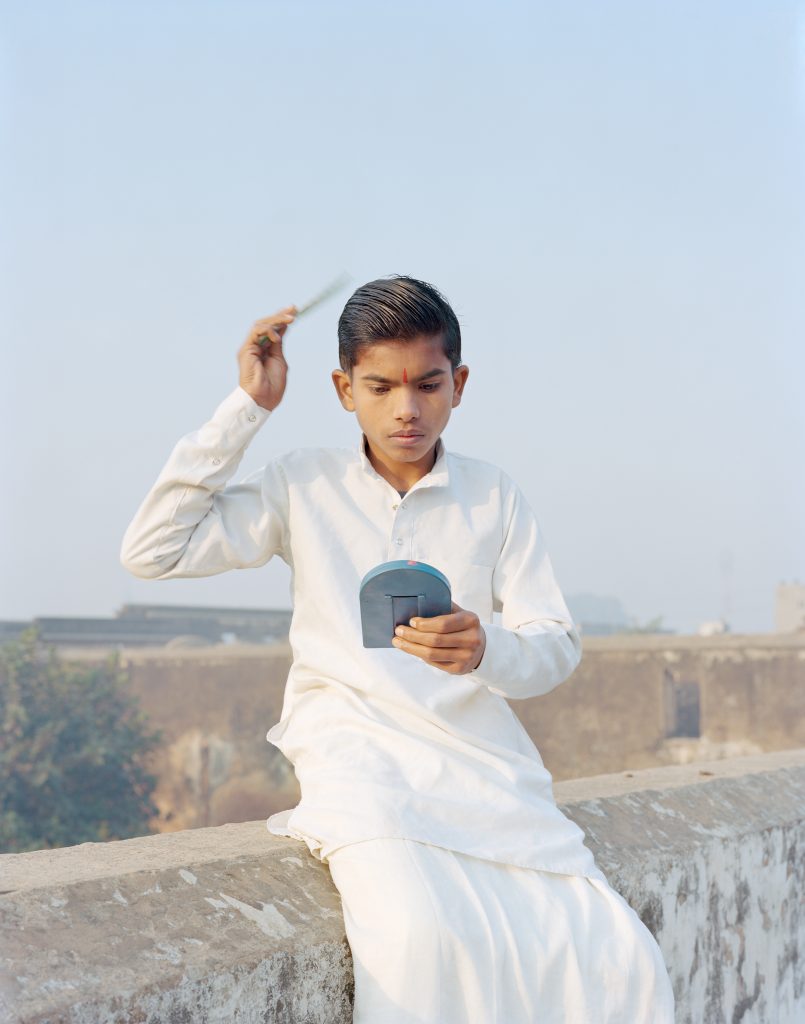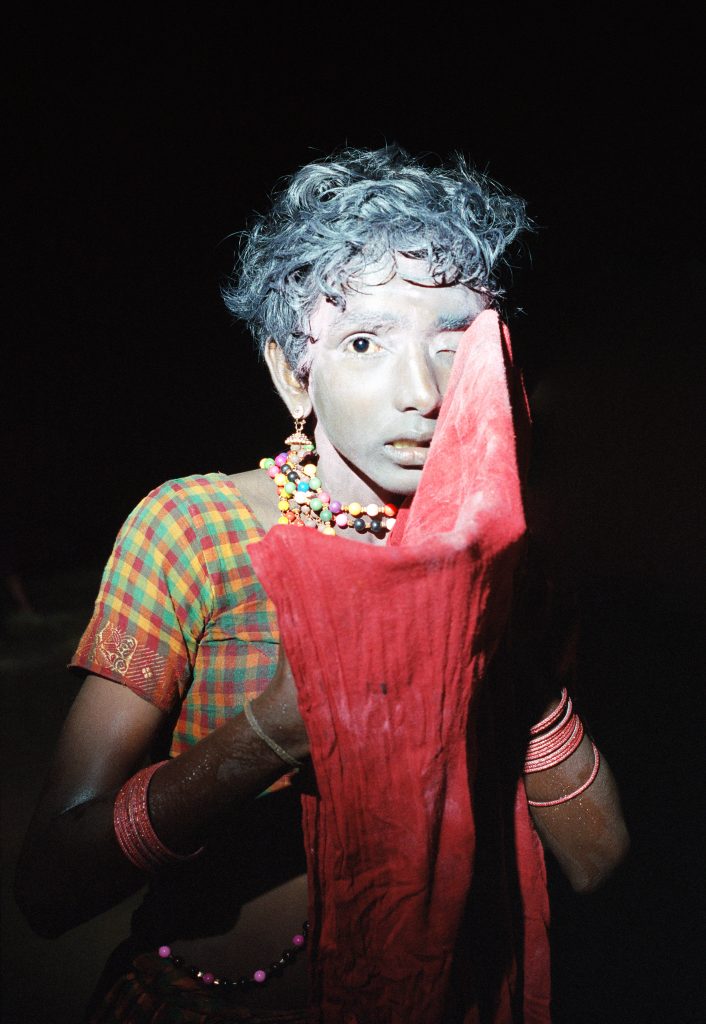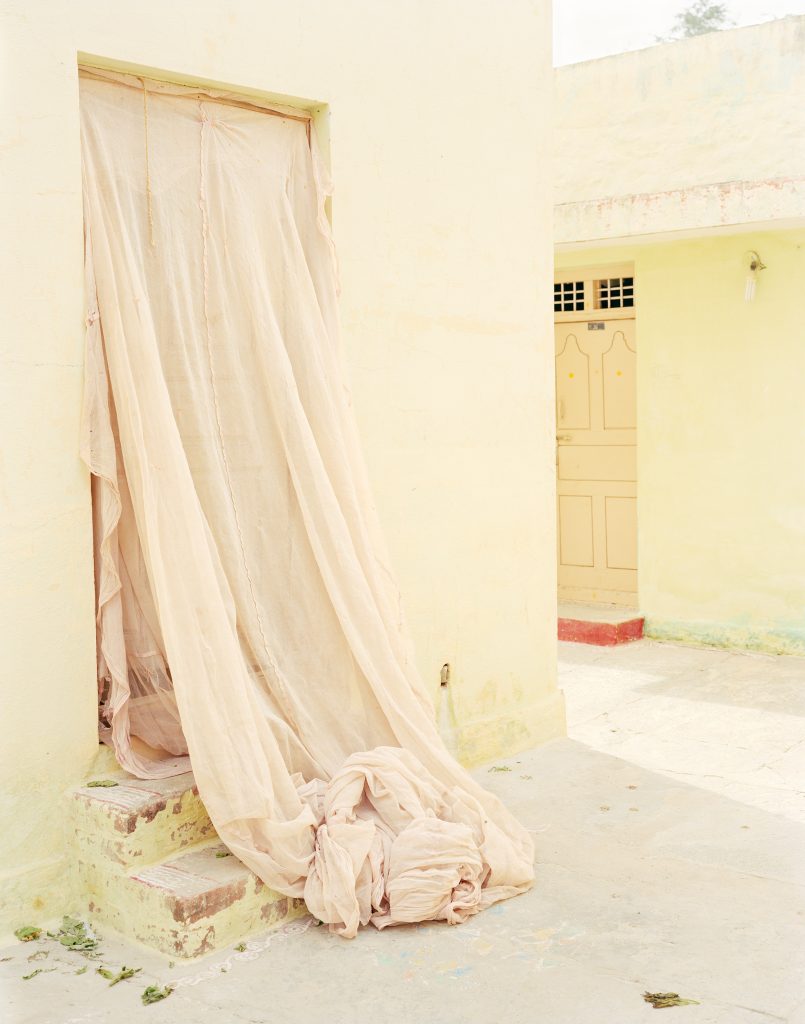A Contemporary Indian Lens: Vasantha Yogananthan

Photographer Vasantha Yogananthan uses a contemporary lens to reimagine India’s founding epic of Hindu mythology, the Ramayana, in his seven-part series A Myth of Two Souls. Yogananthan was born in Grenoble, France, in 1985 to a Sri Lankan father and French mother, though his first visit to the subcontinent was in 2013. With over 13 trips to Nepal, India, and Sri Lanka since then, he retraced the chronicles of Ramayana protagonist Prince Rama, which is filled with themes of love, betrayal, and divinity.
Yogananthan uses everyday life in India as an allegory for the tales of the 4th century love story as he interprets the original seven chapters with seven photography books. He has received several awards including the Prix Levallois (2016) and an ICP Infinity Award as Emerging Photographer of the Year (2017). He was the 2019 laureate of Immersion, a program by the Fondation d’enterprise Hermès. His work will show at SFMOMA (San Francisco) and the Fondation Henri Cartier-Bresson in 2021. He is currently based in Marseilles.
As he approaches the end of his long-term project, FRONTRUNNER discovers how it began, his journey over the years, and where he will go from here.

Rama Combing His Hair (2015)
Ayodhya, Uttar Pradesh, India, from Early Times
Courtesy of the artist
©Vasantha Yogananthan / Chose Commune
Before we talk about your most recent book for the seven-part series, let’s go back a bit. A Myth of Two Souls is a contemporary reimagining one of India’s most sacred texts, the Ramayana. How did this project begin?
It is hard to pinpoint where and how, but it began in a candid way. I’d always wanted to explore India and Sri Lanka. Although I was a complete outsider, that part of the world was very much a part of me. My dad is Tamil and fled Sri Lanka during the civil war, though we never visited when I was a kid and he never spoke of his own country. I had no idea where to begin.
Prior to my first trip to India in 2013, I went to the bookshop. I think I picked the Ramayana because it is so well-known. When I got to India in 2013, I saw so much imagery related to the Ramayana in real life. Perhaps my subconscious was looking for a connection. For example, when I was in Ramaswaran, Tamil Nadu an Island in Tamil Nadu facing Sri Lanka, it was strange because it is just empty beach for hours. Yet there were so many families from all over the country there to see Rama’s bridge and they explained to me that it was a trip you must do at least once in your lifetime. This was when I began to understand a deeper connection between the people, the land, and the physical space. For the west, the Ramayana is a fiction. Though through my travels, the line between fiction and reality became blurred.
I had no idea it was going to end up being an eight-year project. As I re-read the epic, I realized that each of the seven chapters were essential, so my publisher and I decided to go for this crazy seven-book project.
We are often taught to think in categories, to separate mythology from “real life”. This isn’t the only binary your work deconstructs. I noticed in your earlier chapters that the photos blur the boundary between documentary photography and painting.
The division between reality and mythology that is common in the west can also be found in the production and categorization of art. The fine arts and documentary are treated as separate entities. In France, there is photographie plasticienne, or staged photography, and then there is documentary, where one records exactly what they see. I mix both. I think that for some people it is strange that I do not do one or the other. Documentary photographers are always picking a place and a community. I felt that the Ramayana was a way to do something a bit more complex than simply documenting a place.

Tear Gas (2019)
Kulasekharapatnam, Tamil Nadu, India, from Afterlife
Courtesy of the artist
© Vasantha Yogananthan / Chose Commune
It is definitely complex! How did you get into photography?
When I was 17 or 18, I was fascinated with the dark room. That is such a classic answer! Every photographer speaks about the dark room, but I did spend most of my nights producing black and white prints. I never went to art school and I did not think it was possible to make a living out of this. For me, it was just something I loved to do, so I kept doing it. I moved to Paris and was lucky because I found a job in a documentary photo agency as a picture editor. For me, this was the best school. It was how I entered photography and how I started to think deeper about the art of taking photographs, as well as the decisions you make throughout the process.
The series frequently uses everyday life as an allegory for the tales of the epic. What else informs where you travel to and who or what you photograph?
There are two components. The first is entirely research-based. Thank God we live in age of Internet. The original Ramayana mentions places but with very few indications on their exact location. So, I spend hours on obscure blogs where people share local stories and talk about specific cities in relation to the epic. There are so many different perspectives of the same epic – everyone is making it their own.
After the research phase, I would go to India and travel with a young photographer from the state I was going to so they could translate for me. We would have a very rough itinerary planned, and it often changed due to unexpected encounters. This element of chance is the second component and is very much of the core of the project.

The Soothsayer (2015)
Mumbai, Maharashtra, India, from Early Times
Courtesy of the artist
©Vasantha Yogananthan / Chose Commune
The internet provides a fascinating archive, especially in its ability to show how epic is alive today and how people continue to reinterpret and relate to it. As you retraced the journey of Rama from North to South India, what was your own relationship to this series?
Throughout my childhood my dad had the incredibly popular Amar Chitra Katha comic books about the Ramayana. If you conducted a survey throughout the diaspora, you would find that often the first point of access to the Ramayana is through the comic books, and of course the 1987 tv series. It’s funny, because my dad, being a good Sri Lankan, thinks Prince Rama is the bad guy. This character is highly controversial – especially in today’s India. He is so loved and hated at the same time; this makes him more interesting than a classic hero. That it was I found interesting about the Ramayana – nobody is good or bad.
Although it was subconscious at the time, I think a re-discovery of myself and my thinking occurred. This re-discovery continued to drive me there, but even when I go, I am still an outsider. I don’t speak Tamil because my dad wouldn’t speak it at home. There is that language barrier. So much gets lost in translation. Photography was a way to reconnect.
Your latest book Afterlife witnesses the unravelling of Rama’s character as he descends into darkness. In contrast with the light, luminous portraits and landscapes of previous chapters, Afterlife is disorienting through collage and more fervent hues. Can you talk about this shift?
Back when we published the first chapter in 2016, I remember thinking “how am I going to photograph a battle that is obviously not going to happen in front of me?” This chapter was very difficult to approach from a photographic point of view. The first thing I decided to do was to shoot at night, which I had never done before. It was the best way to push myself out of my comfort zone and lose the confidence I had built throughout the first 5 chapters. I thought shooting at night would be a good way to approach the battle, especially doing so during the festival of Dasara, the celebration of good over evil which happens throughout India. What mattered to me was the tension between light and darkness and how people go from one to the other.
While I was filming, I witnessed people go into a trance. Night after night, minds and bodies get further from each other. It is totally magical because people really transformed themselves. In addition to the literal notion of an afterlife, the title is also about escaping your life to go into the underworld and come back. The idea of a second life. It is very metaphysical. The shooting was very disorienting. So many people were there that I couldn’t even look in the viewfinder. I had a very small 35mm with a flash and I would dance and just take photos without knowing if they were blurry or I got the shot.
It was the opposite of what I did before where I would use a tripod, and everything was set perfectly. If you don’t lose control at some point it will be too staged. One should always run away from perfection. Especially in photographs.

Secret Door, India (2016)
Avani, Karnataka, India, from The Promise
Courtesy of the artist
©Vasantha Yogananthan / Chose Commune
In the first and second chapters from your seven-book project Early Times and The Promise, you worked with local artist Jaykumar Shanker, who hand-painted various black and white images in order to give them color. How did this collaboration happen?
The collaboration with Jaykumar began when I was looking for way to change the viewer’s reading of the photograph through color. Color usually influences the way we understand artworks. When I started to read about the history of photography in India, I learned that their first entry point was through the British. Wealthy families would commission local painters to hand-tint prints. What I found fascinating about this was how Indian artists entered the practice through the art of coloring photographs, not taking them. Very few of these artists are still practicing today, and I thought that this project would be a good way to try and revive the tradition.
The collaboration with Jaykumar began in 2015. Initially it felt like a classic commission. He would receive a box of prints and I would get them back 6 months later in France. I gave him no indication of how I would like the photographs to be painted. Our collaboration built over time and the more he got into the project, the more he lent himself into his own sensibility to color and towards the pictures. Magic Jungle (2015) is an example of this. When I got this painting back, I was blown away. The way he paints is not completely real nor unrealistic at the same time. We are so close in vision. He is also such a great guy. For me, he is a real artist.
When you are in your studio, do you already have ideas of how you want a chapter to look?
It is a mix of both. While travelling, I always had a story with me and a lot of notes and ideas about what I am trying to portray. I would try to travel with eyes wide open. I tried not to overthink things, because then you end up photographing things based on your pre conceived notions, and you miss a lot of chance encounters. That is something I love about photography as an art form, from the framing to shooting, it very physical. It is close to a sport. Each time you go out, you feel like you are starting from scratch. Once I am back in the studio, it is all about editing and sequencing. It is highly conceptual. Sometimes I think the sequence will never be good enough and my brain will explode.

Magic Jungle (2016)
Jog Falls, Karnataka, India
Black and white C-print hand-painted by Jaykumar Shankar from Dandaka
Courtesy of the artists
Are you still in Paris? As a photographer who travels immensely, how has your practice shifted since the pandemic?
I am no longer in Paris, this past spring I moved to Marseilles for my next project. I am incredibly lucky because my last trip to India was in 2019, so I do not need to travel for more photos. The final book will be published next year. After eight years of travelling, I feel the need to come back to my own country. What I can say about the new project is that it doesn’t require travelling far and that unlike A Myth of Two Souls, it will not follow a specific narrative. I’ve never photographed home. American photographers are so good at doing that. We French photographers rarely do it. It will be new for me.
Obviously COVID-19 is awful and terrible for so many. There is a temptation for many photographers is to go out and travel far. Of course, I had the opportunity to travel and it was a lifetime experience. Yet ecologically speaking, doesn’t it make sense to try and think “is it essential to travel there?” or “can I do this from home?” I think photographers need boundaries and it gives us something to work with.